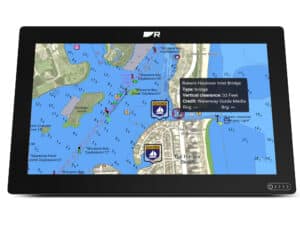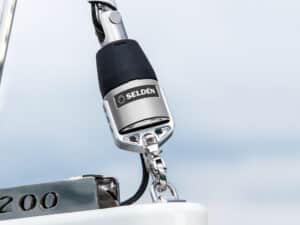
Andrew Burton Gill 368
I’m back at my desk at Cruising World after a 30-day transatlantic passage from Antigua to Italy via Sint Maarten and the Azores, a distance of about 4,600 miles. Along the way I had a chance to put to the test both new gear and some that I’ve previously written about in my New Products column.
I started in Antigua, where the boat, a Swan 651 called White Knight, was competing in Sailing Week. It was hot, especially for someone coming straight off the plane from a chilly New England spring. A pleasant surprise was how well the Harken Rash Guard ($40) worked. This comfortable, long-sleeve top has an S.P.F. rating of 50, and I was actually cooler with it on than off. Made of nylon and Spandex, it’s not particularly flattering for those of us whose physiques lean more toward a keg than a six-pack, but cruisers will find it a good bit of kit for tropical sailing when away from the public eye.
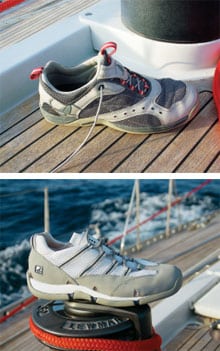
****| |Harken’s Vortex and Sperry Top-Sider’s FIGAWI2 Mesh shoes kept the crew’s toes happy as clams.|
I also tried a pair of Harken’s new Vortex Deck Shoes ($85), and they were comfortable right out of the box. The sure grip of the sole and the light weight made them the choice over bare feet during the races and whenever there was likely to be deck work on our passage. I found that they dried quickly, and even better, they don’t stink at all! One member of my crew, Annie Caswell, was similarly impressed with her Sperry Figawi2 Mesh shoes ($90). They didn’t absorb water and drained quickly through ports on the sides and the sole. She liked the toughness and comfort of the shoe so much that she bought a second pair to wear off the boat as she walked around our ports of call.
While sailing through a cold front a few days out, the wind came up suddenly, and I leaped to the wheel. I was wearing my Gill ensemble: Escape Quick-Dry Shorts ($56), Sonar Polo shirt ($42), and Inshore Sport Jacket ($120). The rain started coming down in buckets, and I was underdressed, but I was surprised to find that the mesh-lined tropical-weight jacket was perfectly waterproof-and I would’ve known had there been the slightest leak-and the hood was more than adequate; the fast-wicking polyester Polo made a good underlayer, and its collar kept my neck comfortable as I watched the rest of the crew tucking in a reef. Rivers of rainwater ran off my jacket and onto my shorts, which, though they got soaked, didn’t get at all cold and clingy, as cotton shorts would have. Earlier, in the sunshine, those same shorts had proven cool and comfortable.
It didn’t stop raining for two days, allowing us to discover more than a few deck leaks, including one right over the Harken Squall Bag ($95) that contained all my clean clothes. Fortunately, due to the waterproof fabric and water-resistant zipper, not a drop made it onto my gear.
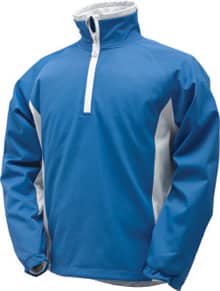
****| |The windproof and waterproof Atlantis numbers softshell pullover has a fleece lining.|
With the weather getting a little less torrid after the front, the Atlantis Numbers Softshell Pullover ($275) I’d been wearing solely as night-watch apparel began to come out during the day. Along with the Gill Polo shirts, this pullover was the piece of gear I wore the most, from damp tropical nights in the Caribbean to the cool northwesterly gale of a mistral in the Mediterranean. Its stretchy, windproof, and waterproof fabric and light fleece lining made it my choice most of the time, and, not that there was anyone around to notice, it’s really good-looking, too.
As we neared the Azores, nighttime temperatures in the 50s F made a pair of Gill i5 Crosswind Salopettes ($150) a welcome midlayer under foul-weather gear and, when the weather was dry, a good top layer. They were warm and waterproof, and I pulled them on over shorts, as it never got cold enough to break out long johns. When the spray was really flying, I used the Line 7 Ocean Jacket and Trousers ($1,025). Their three layers of waterproof breathable fabric kept me snug and dry. Because they’re unlined, both items are fast drying, and the pants are easy to pull on and take off over boots. The collar lived up to expectations, keeping my face and neck dry and comfortable.
I’ve written about my Dubarry Shamrock boots ($300) before. After three years of fairly heavy use, I haven’t changed my mind about any of the good things I’ve said about these breathable Gortex and leather boots: At the end of a watch, my feet never come out of these boots damp and chilly, as they often did with plain rubber boots.
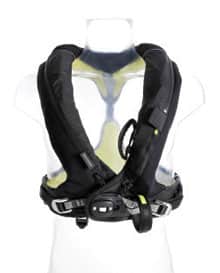
****| |Spinlock’s deck Vest safety harness and inflatable life jacket draws high marks for light weight and comfort.|
I wore a Spinlock Deck Vest inflatable safety harness ($365) every night and on many days during the passage. It was exceedingly easy to get used to, lightweight, and easy to don and adjust for whatever gear I wore underneath. The quality is as high as it can be. The complementary tether worked well, too, though I’m not a fan of the safety carabiners that are mandated by the offshore-racing authorities. Also from Spinlock was the Mast Pro harness ($175), a marine adaptation of a rock-climbing harness that replaces a bosun’s chair. It features a wide, padded belt and even wider padded adjustable leg belts for your thighs. Not only is this much more comfortable to use for long periods while working up the stick; it’s also considerably safer than any bosun’s chair because you can never come out of it.
One of the coolest things I tried was the SPOT Satellite Messenger ($170). This little device e-mails a daily message you select-mine was “Everything’s fine on White Knight”-and at the same time it sends your latitude and longitude and a link to your Google Earth position. I naturally put my wife on the recipient list; she tracked me every noon, calculating how much more time she had to relax and play-I mean, how much longer she’d be missing me. Also on the list, my boss, CW editor John Burnham, knew how much longer he had to farm out my editing duties, and the owner of the boat knew where his pride and joy was every day. There was room for each crewmember to add a contact or two as well. Given the cost, it’s a worthwhile device and a good value at $100 a year for the satellite service. Two other functions allow you to ask your listed recipients for help or to alert rescue services to come to your aid in an emergency-sort of like an EPIRB, though the company is very clear that the SPOT is not a substitute for an EPIRB. The folks at home were glad to know that all aboard were safe, and it’s earned a spot in my seabag from now on.
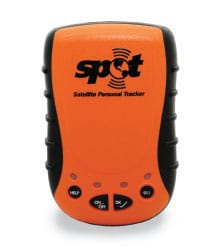
****| |SPOT is a wireless personal tracker that sends limited messages home via satellite.|
I’m not all that old, but when I first went offshore, communications back home were spotty and good cotton long underwear under wool sweaters was the norm. You kept dry(ish) with rubber, nonbreathable gear with snaps to keep the jacket closed. Offshore sailing may still involve a small boat, wind and sea, but the new gear that’s evolved allows sailors to be much more comfortable.
Andrew Burton, a longtime delivery captain, is a CW associate editor.
Gear Contacts:
Atlantis Weather Gear:
(877) 333-7245,
www.atlantisweathergear.com
Dubarry USA:
(919) 854-4460,
www.dubarry.com
Gill: (800) 822-6504,
www.gillna.com
Harken: (262) 691-3320,
www.harken.com
Line 7: +64 -9-308-7700,
www.line7.co.nz
Sperry: (800) 247-6575,
www.sperrytopsider.com
Spinlock: (401) 845-9700,
www.spinlockusa.com
SPOT Satellite Messenger:
(866) 651-7768,
www.findmespot.com



